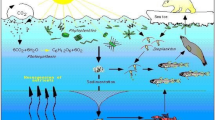Abstract
Changes of phytoplankton populations in Rostherne Mere in 1996 were examined by means of simulation mathematical models. Simple models, solely based on Monod or Michaelis Menten equations, failed to give a reasonable simulation of the phytoplankton succession. A more complex model Rostherne (version 1.1a) calibrated on an extensive set of XRMA and conventional data, however, proved to be useful both for prediction of the outcome of the spring and summer competition and for the estimation of values of certain non-measured variables. It also helped to identify the limiting factors for different times of the year. Alteration of the simulated magnitude of the spring diatom bloom had a major influence on summer cyanobacterial maxima, demonstrating fine regulation of the biogeochemical balance within the modelled system.
Similar content being viewed by others
References
Carvalho, L., 1993. Experimental limnology on four Cheshire meres. PhD Thesis. The University of Liverpool.
Carvalho, L., M. Beklioglu & B. Moss, 1995. Changes in a deep lake following sewage diversion - a challenge to the orthodoxy of external phosphorus control as a restoration strategy? Freshwat. Biol. 34: 399–410.
Cherwell Scientific Publishing Limited, 1997. Model Maker User Manual.
High Performance Systems, Inc., 1996. Stella Software Technical Documentation.
Jorgensen, S. E., 1995. State of the art of ecological modelling in limnology. Ecol. Mod. 78: 101–115.
Howard, A., A. E. Irish & C. S. Reynolds,1996. SCUM'96: a new simulation of cyanobacterial movement. J. Plankton Res. 18: 1375–1385.
Krivtsov, V., 1995. Monitoring of the summer algal bloom using XRMA. Msc Thesis. The University of Manchester.
Krivtsov, V., E. G. Bellinger, D. C. Sigee & J. Corliss, 1998. Application of SEM XRMA data to lake ecosystem modelling. Ecol. Mod. 113/1–3: 95–123.
Moss, B., S. McGowan & L. Carvalho, 1994. Determination of phytoplankton crops by top-down and bottom-up mechanisms in a group of English lakes, the West Midland Meres. Limnol. Oceanogr. 39: 1020–1029.
Moss, B., M. Beklioglu, L. Carvalho, L. Kilinc & S. McGowan,1997. Vertically-challenged limnology; contrasts between deep and shallow lakes. Hydrobiologia 342/343 (Dev. Hydrobiol. 119): 257–267.
Recknagel, F., M. Hosomi, T. Fukushima & D. S. Kong, 1995. Short-and long-term control of external and internal phosphorus loads in lakes - a scenario analysis. Wat. Res. 29: 1767–1779.
Reynolds, C. S. & E. G. Bellinger, 1992. Patterns of abundance and dominance of the phytoplankton of Rostherne Mere, England: evidence from an 18 year data set. Aquat. Sci. 54: 10–36.
Reynolds, C. S. and C. Sinker, 1976. The Meres: Britains eutrophic lakes. New Scientist 71(1007): 10–12.
Schernewski, G., L. Theesen & K. E. Kerger, 1994. Modelling thermal stratification and calcite precipitation of Lake Belau (northern Germany). Ecol. Mod. 75/76: 421–433.
Sigee, D. C. & R. Holland, 1997. Elemental composition, correlations and ratios within a population of Staurastrum planctonicum (Zygnematales): an X-ray microanalytical study. J. Phycol. 33: 182–190.
Sigee, D. C, V. Krivtsov & E. G. Bellinger, 1998. Elemental concentrations, correlations and ratios in micropopulations of Ceratium Hirundinella (Pyrrhophyta): an X-ray microanalytical study. Eur. J. Phycol. 33: 155–164.
Skalar Analytical B. V., 1993. Skalar automated N & P analyser. Publication No: 0711293. Headquarters Skalar Analytical B.V., P. O. Box 3237, 4800 DE Breda, The Netherlands.
Stephen, D., 1997. The role of macrophytes in shallow lake systems: whole-lake, mesocosm and laboratory approaches. PhD Theses, The University of Liverpool.
Tatersall, W. M. & T. A. Coward, 1914. Faunal survey of Rostherne Mere. Mem. and Proc. Manchester. Lit. Phil. Soc. 58: 1–21.
Woof, C. & T. Wall, 1984. The morphometry of Rostherne Mere, Cheshire. Naturalist 109: 143–146.
Author information
Authors and Affiliations
Corresponding author
Rights and permissions
About this article
Cite this article
Krivtsov, V., Sigee, D., Corliss, J. et al. Examination of the phytoplankton of Rostherne Mere using a simulation mathematical model. Hydrobiologia 414, 69–74 (1999). https://doi.org/10.1023/A:1003854929525
Issue Date:
DOI: https://doi.org/10.1023/A:1003854929525




